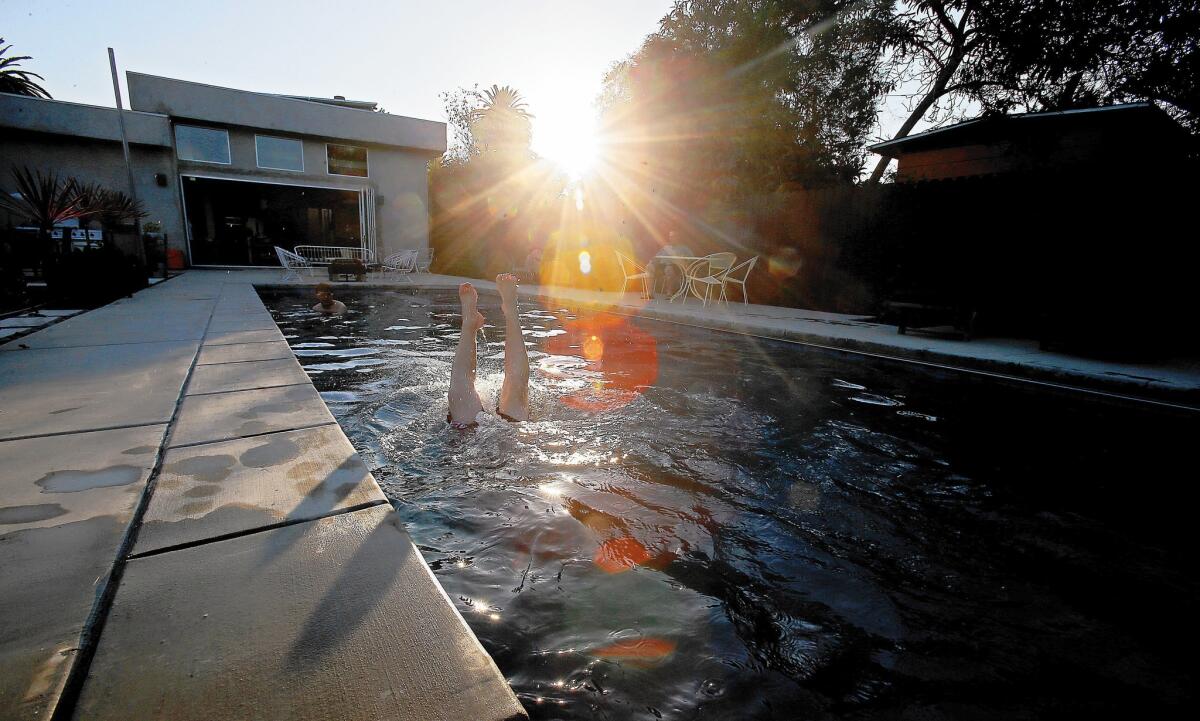Water agencies are learning pools aren’t a big factor during drought

- Share via
The Sieferts are the kind of environmentally conscious family who attend local sustainability workshops and have solar panels atop their Mar Vista home. They use timers on their kids’ showers and have planted drought-tolerant landscaping.
But they feel a twinge of guilt over their beloved 52-foot-long swimming pool.
“I haven’t thought about the pool as much as I probably should,” said Annette Siefert, 50. “But I think we’ve done everything we can do not to be wasters.”
As California’s drought worsens, swimming pools have become a target for those who think the classic backyard oasis wastes water. Some water districts have prohibited new pools from being filled and have limited how much water existing pools can use.
But some of those agencies are walking back the rules as they make a surprising discovery: Pools aren’t the water wasters some have made them out to be.
Analyses by various water districts, along with scientific studies, conclude that pools and their surrounding hardscapes use about the same amount of water as a lawn of the same size. Over time, pools might even use less water. With pool covers, experts say water evaporation can be cut by almost half, making pools significantly less wasteful than grass and about as efficient as drought-tolerant landscaping.
Facing complaints over a recent ban on filling pools, the Santa Margarita Water District conducted its own water-use analysis. It found that pools require thousands of gallons of water to fill initially, but they use about 8,000 gallons less water than a traditional landscape after that. By the third year, the analysis found, the savings add up, and a pool’s cumulative water use falls below that of a lawn.
Water agencies such as the Los Angeles Department of Water and Power have come to similar conclusions.
Armed with new information, Santa Margarita Water District officials will reconsider their ban next week.
“We want to respect the people’s rights to use their property. There are many families we know that have saved for pools,” said Jonathan Volzke, spokesman for the 155,000-customer district. “But at the same time, the reality around us is that we’re in the third year of a serious drought, and we don’t know if we’re in the third year of a three-year drought or the third year of a 10-year drought.”
At least two California water distributors have rolled back pool-filling limitations after being contacted by the pool lobby and crunching the numbers.
In Sacramento County, the Carmichael Water District had banned filling new swimming pools but later moved the restriction to a more severe drought stage after officials realized that the district’s customers had already reduced their overall water use by 20%.
About 50 miles northeast of Carmichael, the Placer County Water Agency decided against enacting a pool-filling restriction for existing pools after an analysis showed that the amount of water used for pools was inconsequential compared with total water use.
The approximately 75 new pools the agency permitted in 2013 consumed about 6 acre-feet of water, said Tony Firenzi, deputy director of technical services. For comparison, he said, the agency doles out more than 100,000 acre-feet of water per year to its approximately 38,000 customers.
“You would have to be in very, very desperate conditions to be at a point where water that is consumed at a restaurant or water that is used for filling of a pool is significant enough to change the situation,” he said.
The Los Angeles DWP has yet to enter the phase of its conservation plan that prohibits filling residential swimming pools with drinkable water. The department has emphasized reducing irrigation and landscaping before turning to pools, a spokeswoman said. That means that Annette Siefert and her family can keep swimming — at least for now.
Siefert grew up in California and has always had a pool nearby. When her family bought a 16,000-square-foot lot, she knew a pool would go in the backyard.
Her son Casey, 15, has epilepsy, which can make leaving home hard. Nolan Siefert, 17, has Asperger’s syndrome, and doesn’t usually like going out. The pool is an important center of the family’s staycations — a sanctuary where Annette can keep an eye on her kids from the kitchen.
On a recent weekday, Nolan cannonballed into the deep end as the sun began to set. Casey dove in after, drawing his parents’ praise.
“It’s here now, and I would never consider emptying the pool,” Annette said. “At some point you just live. This is what makes us really happy.”
[email protected]
Twitter: @MattStevensLAT
More to Read
Sign up for Essential California
The most important California stories and recommendations in your inbox every morning.
You may occasionally receive promotional content from the Los Angeles Times.











